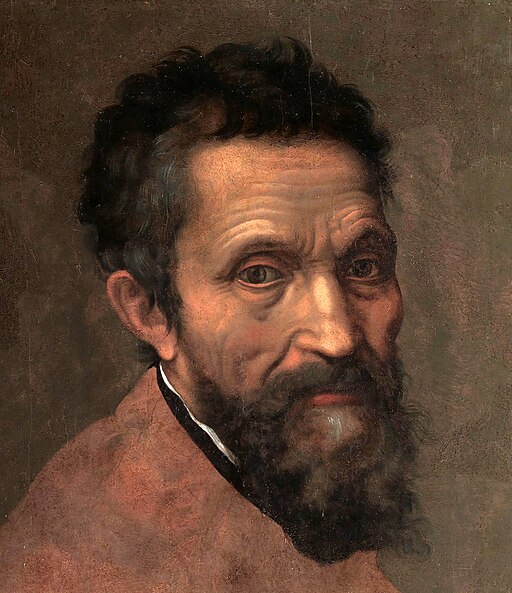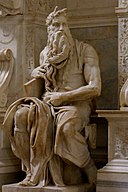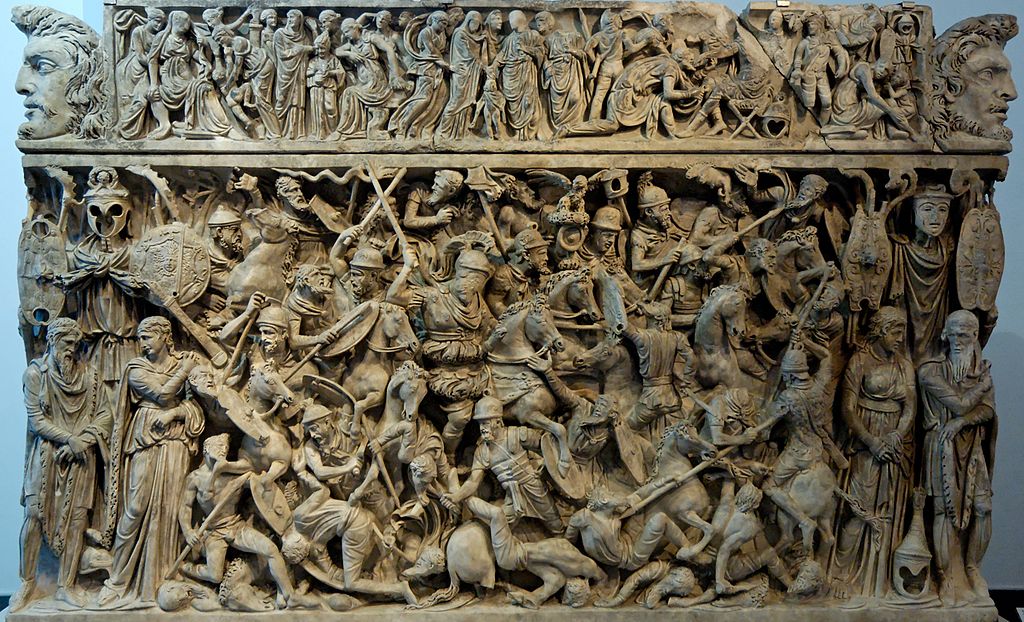
Michelangelo (1475 – 1564) was an Italian sculptor, painter, architect, and poet of the Renaissance who was born in Florence, and who had a significant influence on the development of Western art.
He is one of the greatest artists of all time. He is often considered as a contender for the title of the leading representative of Renaissance man, along with his rival, Leonardo da Vinci.
A Virtual Tour of Michelangelo
- David
- Pietà
- Moses
- Sistine Chapel Ceiling
- Studies of a Reclining Male Nude
- Young Slave
- Bearded Slave
- Rebellious Slave
- Doni Tondo or Doni Madonna
- “Leda and the Swan” after Michelangelo
- The Holy Family with St John the Baptist
Highlights of Michelangelo’s Masterpieces
David
“David” by Michelangelo was completed in 1504 and depicts the Biblical hero David, who killed the giant Goliath with a rock from his sling.
David is represented just before his battle with Goliath, tense and ready for combat, Michelangelo has captured the moment between decision and action, during the war between Israel and the Philistines. Museum: Galleria dell’Accademia, Florence, Italy

Pietà
Pietà by Michelangelo depicts the body of Jesus on the lap of his mother Mary after the Crucifixion. The Pietà theme is of Northern European origin.
However, Michelangelo’s interpretation of the Pietà was unprecedented in Italian sculpture. It balanced the Renaissance ideals of classical beauty together with extraordinary naturalism.
Christ’s face does not reveal signs of his suffering. Michelangelo did not want his version of the Pietà to represent death, but rather to show the serene faces and relationship of Son and Mother.
It is the only piece Michelangelo ever signed. Museum: St. Peter’s Basilica, Vatican City

Moses
Moses, by Michelangelo, depicts the biblical figure of Moses with horns on his head. It is based on a description in chapter 34 of Exodus in the Latin translation of the Bible used at that time.
Moses is seated with his right arm protecting the stone tablets bearing the Ten Commandments while fondling his beard with two fingers. His long beard is rendered in sculpture, as soft flowing ringlets of hair that flow like waterfalls from his face.
Moses’s other hand displays his throbbing veins, tense muscles, at the tail end of his snake-like beard. He appears alert to any threat and ready to defend the tablets with violent action.

Sistine Chapel Ceiling
The Sistine Chapel is the room where the College of Cardinals are locked in and required to decide on the next Pope.
The walls and the ceiling are masterfully decorated. The walls are painted with frescoes by various artists, and Michelangelo painted the Masterpiece of the ceiling fresco. Museum: Vatican Museums

Studies of a Reclining Male Nude
“Studies of a Reclining Male Nude” is a rare drawing by Michelangelo to have survived. It shows the reclining figure of Adam reaching out to God the Father, whose touch grants him life.
This study of Adam was in preparation for the fresco of ‘The Creation of Man.’ It was used for the painting on the vault of the Sistine Chapel. It was drawn in dark red chalk over some stylus underdrawing.
The reverse side of this paper has a drawing, also in red chalk, of the “Head of a Youth,” turned to the right, wearing a headscarf. Museum: The British Museum
Young Slave
“Young Slave” by Michelangelo is a marble sculpture that Michelangelo started about 1525–1530. It is part of the “unfinished” series of prisoners called “Prigioni” in Italian “intended for the Tomb of Julius II.
In the first version of the tomb of Julius II had a series of prisoners planned for the lowest level of the mausoleum.
It was to be a series of more-than-life-size statues of chained figures in various poses, leaning on the pilasters which framed a set of niches, each of which would contain a “Winged Victory.” Museum: Galleria dell’Accademia, Florence, Italy
Bearded Slave
“Bearded Slave” by Michelangelo is a marble sculpture from about 1525–1530 and forms part of the series of “unfinished” Prigioni intended for the Tomb of Pope Julius II.
In the first version of the tomb of Julius II had a series of prisoners or Prigioni” in Italian, planned for the lowest level of the mausoleum.
It was to be a series of more-than-life-size statues of chained figures in various poses, leaning on the pilasters, which framed a set of niches. Museum: Galleria dell’Accademia, Florence, Italy
Rebellious Slave
“Rebellious Slave” by Michelangelo is a marble sculpture created for the second version of the tomb of Pope Julius II, which was commissioned by the Pope’s heirs in 1513.
Although the initial plans by the Pope for a gigantic mausoleum were set aside, the work was still monumental, with a corridor that was to be richly decorated with sculpture.
Michelangelo was commissioned for this project, and among the first pieces completed were the two “Prigioni” renamed the “slaves” in the nineteenth century. Museum: Musée du Louvre
Doni Tondo or Doni Madonna
Doni Tondo by Michelangelo portrays the Holy Family consisting of the Child Jesus, Mary, and Joseph in the foreground.
John the Baptist is shown in the right with his rough clothing holding a long wooden rod. Five mostly nude male figures are featured at the back by a low wall in the background.
These bare figures have been interpreted in a variety of ways. Mary is the most prominent figure in the composition, sitting on the ground grass with a book on her lap. Joseph is positioned behind Mary as if he is protecting her.
The golden material over Joseph’s legs forms a de facto throne. The Child is being transferred between Joseph and Mary.
Mary and Joseph gaze at Christ. John the Baptist, the patron saint of Florence, is commonly included in Florentine works depicting the Madonna and Child. Museum: Uffizi Gallery
“Leda and the Swan” after Michelangelo
This “Leda and the Swan” painting is a very old copy made after the original painting of a now-lost painting that Michelangelo made in 1530.
Michelangelo showed the Greek god Zeus in the form of a swan seducing Leda, Queen of Sparta. Leda’s pose was influenced by the iconography of older sarcophagus reliefs and gems and is similar to Michelangelo’s marble sculpture “Night” in the Medici Chapel, Florence.
Michelangelo’s Leda echos a painting of a hard-edged marble relief sculpture, rather than the soft voluptuous depictions of a Raphael or Titian.
It is proposed that this copy was made from Michelangelo’s original by Rosso Fiorentino, an Italian patron of the arts. It is also believed that the original was burnt on the grounds of indecency, at the end of the seventeenth century. Museum: National Gallery, London
The Holy Family with St John the Baptist
“The Holy Family with St John the Baptist” is a painting that was created around 1540 by Michelangelo or his close circle. The unfinished drawing using brown brush wash on poplar wood is laid out only in the outer outlines.
The composition depicts a striding mother, who guides the Christ Child, who is standing by her feet, standing with the use of a walking aid. In her the other hand, she holds the boy St. John walking next to her.
Joseph is shown bent over the Christ child, as he provides additional support while he is learning to walk. The depiction may be commemorating the return of the Holy Family from Egypt.
The work is closely associated with Michelangelo, to whom the picture was previously assigned. Some experts considered it a copy by Michelangelo’s circle of an original lost draft by Michelangelo from the 1640s.
Yet, the unusually high quality of the artwork encourages other experts to attribute the work directly to Michelangelo. Museum: Ashmolean Museum
Michelangelo
- Name: Michelangelo di Lodovico Buonarroti Simoni
- Born: 1475 – Caprese near Arezzo, Republic of Florence
- Died: 1564 (aged 88) – Rome, Papal States (present-day Italy)
- Movement: High Renaissance
Michelangelo Biography: Who Was This Guy, Really? | Art History Lesson
Michelangelo Quotes
~~~
“The true work of art is but a shadow of the divine perfection.”
~~~
“My soul can find no staircase to Heaven unless it is through Earth’s loveliness.”
~~~
“An artist must have his measuring tools not in the hand, but the eye.”
~~~
“A man paints with his brains and not with his hands.”
~~~
“If people knew how hard I had to work to gain my mastery, it would not seem so wonderful at all.”
~~~
“I am still learning.”
~~~
“A beautiful thing never gives so much pain as does failing to hear and see it.”
~~~
“I live and love in God’s peculiar light.”
~~~
Biography – The Divine Michelangelo
A Tour of Artists
- Duccio (1255 – 1319)
- Jan van Eyck (1390 – 1441)
- Giovanni Bellini (1430 – 1516)
- Sandro Botticelli (1445 – 1510)
- Domenico Ghirlandaio (1448 – 1494)
- Leonardo da Vinci (1452 – 1519)
- Albrecht Durer (1471 – 1528)
- Lucas Cranach the Elder (1472 – 1553)
- Michelangelo (1475 – 1564)
- Raphael (1483 – 1520)
- Titian (1488 – 1576)
- Hans Holbein the Younger (1497 – 1543)
- Tintoretto (1518 – 1594)
- Pieter Bruegel the Elder (1525 – 1569)
- Paolo Veronese (1528 – 1588)
- El Greco (1541 – 1614)
- Caravaggio (1571 – 1610)
- Peter Paul Rubens (1577 – 1640)
- Georges de La Tour (1593 – 1652)
- Artemisia Gentileschi (1593 – 1656)
- Anthony van Dyck (1599 – 1641)
- Nicolas Poussin (1594 – 1665)
- Diego Velázquez (1599 – 1660)
- Rembrandt (1606 – 1669)
- Pieter de Hooch (1629 – 1684)
- Johannes Vermeer (1632 – 1675)
- Élisabeth Sophie Chéron (1648 – 1711)
- Canaletto (1697 – 1768)
- François Boucher (1703 – 1770)
- Jean-Honoré Fragonard (1732 – 1806)
- John Singleton Copley (1738 – 1815)
- Benjamin West (1738 – 1820)
- Angelica Kauffman (1741 – 1807)
- Francisco Goya (1746 – 1828)
- Jacques-Louis David (1748 – 1825)
- Antonio Canova (1757 – 1822)
- Katsushika Hokusai ( 1760 – 1849)
- Caspar David Friedrich (1774 – 1840)
- J.M.W. Turner (1775 – 1851)
- Jean-Auguste-Dominique Ingres (1780 – 1867)
- William Etty (1787 – 1849)
- Eugène Delacroix (1798 – 1863)
- George Caleb Bingham (1811 – 1879)
- Rosa Bonheur (1822 – 1899)
- Jean-Léon Gérôme (1824 – 1904)
- Dante Gabriel Rossetti (1828 – 1882)
- John Everett Millais (1829 – 1896)
- Frederic Leighton (1830 – 1896)
- Camille Pissarro (1830 – 1903 )
- Édouard Manet (1832 – 1883)
- James Abbott McNeill Whistler (1834 – 1903)
- Edgar Degas (1834 – 1917)
- James Tissot (1836 – 1902)
- Winslow Homer (1836 – 1910)
- Paul Cézanne (1839 – 1906)
- Auguste Rodin (1840 – 1917)
- Claude Monet (1840 – 1926)
- Pierre-Auguste Renoir (1841 – 1919)
- Berthe Morisot (1841 – 1895)
- Henri Rousseau (1844 – 1910)
- Mary Cassatt (1844 – 1926)
- Elizabeth Thompson (1846 – 1933)
- Gustave Caillebotte (1848 – 1894)
- Paul Gauguin (1848 – 1903)
- John William Waterhouse (1849 – 1917)
- Jean Béraud (1849 – 1935)
- Vincent van Gogh (1853 – 1890)
- Frederick McCubbin (1855 – 1917)
- John Singer Sargent (1856 – 1925)
- Tom Roberts (1856 – 1931)
- Lovis Corinth (1858 – 1925)
- Georges Seurat (1859 – 1891)
- Gustav Klimt (1862 – 1918)
- Edvard Munch (1863 – 1944)
- Henri de Toulouse-Lautrec (1864 – 1901)
- Rupert Bunny (1864 – 1947)
- Wassily Kandinsky (1866 – 1944)
- Arthur Streeton (1867 – 1943)
- Pierre Bonnard (1867 – 1947)
- Franz Marc (1880 – 1916)
- Goyō Hashiguchi (1880 – 1921)
- George Bellows (1882 – 1925)
- Edward Hopper (1882 – 1967)
- Amedeo Modigliani (1884 – 1920)
- Fernando Botero (born 1932)
- Artists and their Art
- Women in the Arts
- Famous French Painters You Should Know
The Renaissance – the Age of Michelangelo and Leonardo da Vinci
Women in the Arts
- Élisabeth Sophie Chéron (1648 – 1711)
- Artemisia Gentileschi (1593 – 1656)
- Louise Élisabeth Vigée Le Brun ( 1755 – 1842)
- Marie-Denise Villers (1774 – 1821)
- Rosa Bonheur (1822 – 1899)
- Sophie Gengembre Anderson (1823 – 1903)
- Berthe Morisot (1841 – 1895)
- Mary Cassatt (1844 – 1926)
- Anna Lea Merritt (1844 – 1930)
- Elizabeth Thompson (1846 – 1933)
- Margaret Bernadine Hall (1863 – 1910)
- Artists and their Art
- Women in the Arts
Michelangelo: The Story of a Sculptor (Michelangelo Biography)
~~~
“I saw the angel in the marble and carved until I set him free.”
– Michelangelo
~~~
Photo Credit:Daniele da Volterra [Public domain] 2)Jörg Bittner Unna [CC BY 3.0 (https://creativecommons.org/licenses/by/3.0)] 3)Michelangelo [CC0] 4) Jörg Bittner Unna [CC BY 3.0 (https://creativecommons.org/licenses/by/3.0)] 5)
Popular this Week








 Sponsor your Favorite Page
Sponsor your Favorite Page SEARCH Search for: Search Follow UsJoin – The JOM Membership Program
Sponsor a Masterpiece with YOUR NAME CHOICE for $5
Share this:
- Tweet
